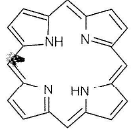Class 12 Exam > Class 12 Questions > In which of the following porphyrin acts as l...
Start Learning for Free
In which of the following porphyrin acts as ligand?
- a)Haemoglobin
- b)Chlorophyll
- c)Vitamin B-12
- d)Insulin
Correct answer is option 'A,B'. Can you explain this answer?
Verified Answer
In which of the following porphyrin acts as ligand?a)Haemoglobinb)Chlo...
he porphyrin ring contains pyrrote unit are linked by four (—CH =)bridges. Porphyrine are derived from porphin, varying according to the nature of substituents. Porphyrin ring act as tetradentate ligands with four pyrole like nitrogens surrounding a central site of metals.. Iron complex of the substituted porphin is here. When magnesium lie at the centre of substituted porphin ring; the resulting complex is called chlorophyll.

Most Upvoted Answer
In which of the following porphyrin acts as ligand?a)Haemoglobinb)Chlo...
The Heme Porphyrin. Although the hemoglobin and myoglobin molecules are very large, complex proteins, the active site is actually a non-protein group called heme. The heme consists of a flat organic ring surrounding an iron atom.
Chlorophylls are numerous in types, but all are defined by the presence of a fifth ring beyond the four pyrrole-like rings. Most chlorophylls are classified as chlorins, which are reduced relatives to porphyrins (found in hemoglobin). They share a common biosynthetic pathway as porphyrins, including the precursor uroporphyrinogen III. Unlike hemes, which feature iron at the center of the tetrapyrrole ring, chlorophylls bind magnesium. For the structures depicted in this article, some of the ligands attached to the Mg2+ center are omitted for clarity. The chlorin ring can have various side chains, usually including a long phytol chain. The most widely distributed form in terrestrial plants is chlorophyll a.
Free Test
| FREE | Start Free Test |
Community Answer
In which of the following porphyrin acts as ligand?a)Haemoglobinb)Chlo...
Understanding Porphyrins as Ligands
Porphyrins are cyclic compounds that can coordinate with metal ions to form complex structures. In biological systems, they play essential roles, particularly in hemoglobin and chlorophyll.
1. Hemoglobin
- Hemoglobin is a protein in red blood cells responsible for oxygen transport.
- It contains heme, a porphyrin structure that coordinates with iron (Fe2+).
- The iron atom binds oxygen, allowing hemoglobin to carry it from the lungs to tissues.
- This coordination makes heme a crucial ligand in the function of hemoglobin.
2. Chlorophyll
- Chlorophyll is the pigment responsible for photosynthesis in plants.
- It contains a porphyrin ring that coordinates magnesium (Mg2+).
- The magnesium ion plays a vital role in capturing light energy, making chlorophyll an essential ligand in this process.
3. Vitamin B-12
- Vitamin B-12 (cobalamin) also contains a porphyrin-like structure, but it primarily functions as a cofactor rather than a ligand in the same context as heme or chlorophyll.
- While it does bind to metals such as cobalt, its primary biological role is not as a ligand like in hemoglobin or chlorophyll.
4. Insulin
- Insulin is a peptide hormone that regulates glucose levels in the blood.
- It does not contain a porphyrin structure and, therefore, does not act as a ligand in this context.
Conclusion
- The correct answers regarding porphyrins acting as ligands are Hemoglobin (A) and Chlorophyll (B).
- Both of these compounds use their porphyrin structures to bind essential metal ions, facilitating crucial biological functions.
Porphyrins are cyclic compounds that can coordinate with metal ions to form complex structures. In biological systems, they play essential roles, particularly in hemoglobin and chlorophyll.
1. Hemoglobin
- Hemoglobin is a protein in red blood cells responsible for oxygen transport.
- It contains heme, a porphyrin structure that coordinates with iron (Fe2+).
- The iron atom binds oxygen, allowing hemoglobin to carry it from the lungs to tissues.
- This coordination makes heme a crucial ligand in the function of hemoglobin.
2. Chlorophyll
- Chlorophyll is the pigment responsible for photosynthesis in plants.
- It contains a porphyrin ring that coordinates magnesium (Mg2+).
- The magnesium ion plays a vital role in capturing light energy, making chlorophyll an essential ligand in this process.
3. Vitamin B-12
- Vitamin B-12 (cobalamin) also contains a porphyrin-like structure, but it primarily functions as a cofactor rather than a ligand in the same context as heme or chlorophyll.
- While it does bind to metals such as cobalt, its primary biological role is not as a ligand like in hemoglobin or chlorophyll.
4. Insulin
- Insulin is a peptide hormone that regulates glucose levels in the blood.
- It does not contain a porphyrin structure and, therefore, does not act as a ligand in this context.
Conclusion
- The correct answers regarding porphyrins acting as ligands are Hemoglobin (A) and Chlorophyll (B).
- Both of these compounds use their porphyrin structures to bind essential metal ions, facilitating crucial biological functions.

|
Explore Courses for Class 12 exam
|

|
Question Description
In which of the following porphyrin acts as ligand?a)Haemoglobinb)Chlorophyllc)Vitamin B-12d)InsulinCorrect answer is option 'A,B'. Can you explain this answer? for Class 12 2025 is part of Class 12 preparation. The Question and answers have been prepared according to the Class 12 exam syllabus. Information about In which of the following porphyrin acts as ligand?a)Haemoglobinb)Chlorophyllc)Vitamin B-12d)InsulinCorrect answer is option 'A,B'. Can you explain this answer? covers all topics & solutions for Class 12 2025 Exam. Find important definitions, questions, meanings, examples, exercises and tests below for In which of the following porphyrin acts as ligand?a)Haemoglobinb)Chlorophyllc)Vitamin B-12d)InsulinCorrect answer is option 'A,B'. Can you explain this answer?.
In which of the following porphyrin acts as ligand?a)Haemoglobinb)Chlorophyllc)Vitamin B-12d)InsulinCorrect answer is option 'A,B'. Can you explain this answer? for Class 12 2025 is part of Class 12 preparation. The Question and answers have been prepared according to the Class 12 exam syllabus. Information about In which of the following porphyrin acts as ligand?a)Haemoglobinb)Chlorophyllc)Vitamin B-12d)InsulinCorrect answer is option 'A,B'. Can you explain this answer? covers all topics & solutions for Class 12 2025 Exam. Find important definitions, questions, meanings, examples, exercises and tests below for In which of the following porphyrin acts as ligand?a)Haemoglobinb)Chlorophyllc)Vitamin B-12d)InsulinCorrect answer is option 'A,B'. Can you explain this answer?.
Solutions for In which of the following porphyrin acts as ligand?a)Haemoglobinb)Chlorophyllc)Vitamin B-12d)InsulinCorrect answer is option 'A,B'. Can you explain this answer? in English & in Hindi are available as part of our courses for Class 12.
Download more important topics, notes, lectures and mock test series for Class 12 Exam by signing up for free.
Here you can find the meaning of In which of the following porphyrin acts as ligand?a)Haemoglobinb)Chlorophyllc)Vitamin B-12d)InsulinCorrect answer is option 'A,B'. Can you explain this answer? defined & explained in the simplest way possible. Besides giving the explanation of
In which of the following porphyrin acts as ligand?a)Haemoglobinb)Chlorophyllc)Vitamin B-12d)InsulinCorrect answer is option 'A,B'. Can you explain this answer?, a detailed solution for In which of the following porphyrin acts as ligand?a)Haemoglobinb)Chlorophyllc)Vitamin B-12d)InsulinCorrect answer is option 'A,B'. Can you explain this answer? has been provided alongside types of In which of the following porphyrin acts as ligand?a)Haemoglobinb)Chlorophyllc)Vitamin B-12d)InsulinCorrect answer is option 'A,B'. Can you explain this answer? theory, EduRev gives you an
ample number of questions to practice In which of the following porphyrin acts as ligand?a)Haemoglobinb)Chlorophyllc)Vitamin B-12d)InsulinCorrect answer is option 'A,B'. Can you explain this answer? tests, examples and also practice Class 12 tests.

|
Explore Courses for Class 12 exam
|

|
Signup for Free!
Signup to see your scores go up within 7 days! Learn & Practice with 1000+ FREE Notes, Videos & Tests.


















